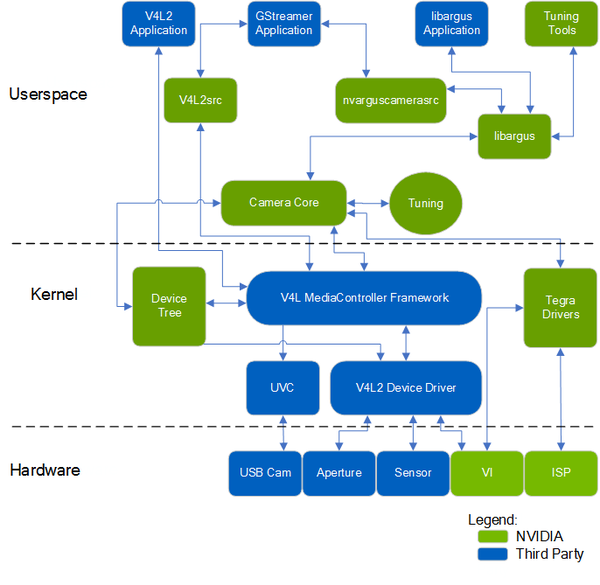NVIDIA Jetson Xavier - Overview of the video capture and display subsystem

|
The NVIDIA Xavier has a video capture subsystem that allows image capture from camera sensors and does image processing. The Xavier SOM also integrates a display controller and three independent display outputs. In this section, you will get a general knowledge of the principal characteristics of the video capture subsystem: interfaces and formats supported, system modes, and image processing capabilities. Also, you will learn about the available software for this subsystem and how to use it.
Likewise, a list of cameras/decoders supported for this platform by NVIDIA or by RidgeRun will be provided.
Contents
Camera Architecture Stack
The Linux for Tegra architecture framework with the application and kernel-mode V4L2 drivers is as follows:
Available Camera Interfaces
The following table summarizes the different standard interfaces that could be used to interface a camera module with the SoM.
| Interface | Description |
|---|---|
| 3xUSB 3.1 | Has support for 1080p@60FPS video and is backward compatible with USB 3.0 and USB 2.0 |
| Micro-USB 2.0 OTG | Used through a micro-B to female USB-A adapter has enough bandwidth for video 720p@30FPS. |
| Gigabit Ethernet | Allows support for IP Cameras and has enough bandwidth for uncompressed 1080p video streams |
| MIPI CSI-2 | Provides direct access to the ISP and can support up to 4 quad lane cameras or four dual-lane cameras plus two quad lane cameras or 6 dual-lane cameras (total of 6 in any configuration). It can also support up to 16 cameras via the virtual channel. |
| PCIe | This connector allows for the connection of SLVS cameras |
| GPIOs | 40-pin GPIO header allows for communication cameras that follow the UART, SPI, or CAN protocol |
Video Input Subsystem (VI)
The Video Input (VI) subsystem is in charge of taking data from the MIPI-CSI receiver and preparing it for either the Image Signal Processor or the system memory. It provides formatting for RGB, YCbCr, and raw Bayer data for up to six active streams.
Further information will be added when the Xavier technical reference manual is released |
Image Signal Processor (ISP)
The Image Signal Processor (ISP) takes data from the Video Input Subsystem or directly from the CSI block in raw Bayer format and processes it to YUV, and removes artifacts introduced by high-megapixel CMOS sensors, camera lens, and color-space conversion.
The ISP enables various features such as:
- CSI Virtual Channel allows for up to 16 total virtual channels.
- Local Tone Map.
- Bayer Histogram statistics for auto-exposure.
- Bayer average map for auto white balance and auto-exposure.
- Sharpness map for autofocus.
- Parity Protection
- Bad pixel count.
- Deadlock detection.
Further information will be added when the Xavier technical reference manual is released. |

